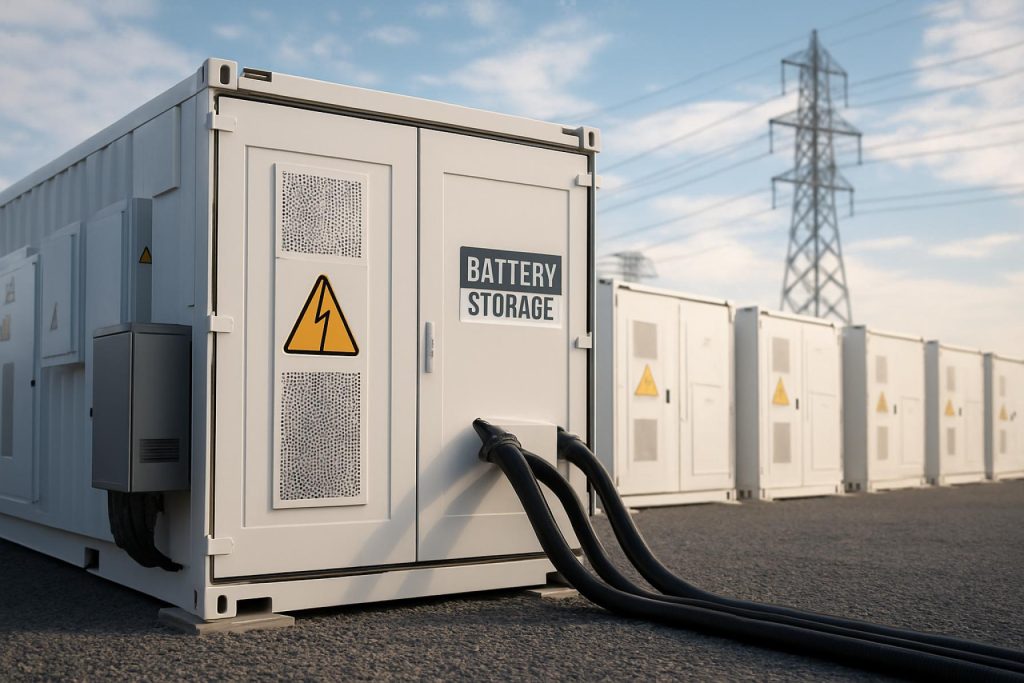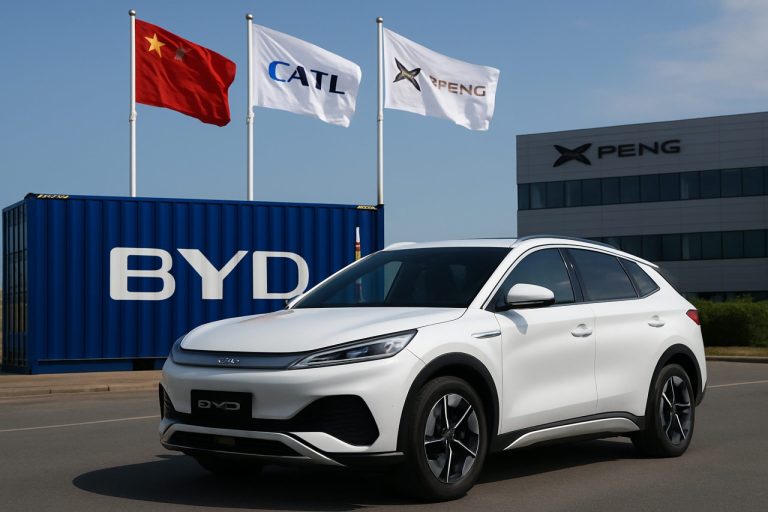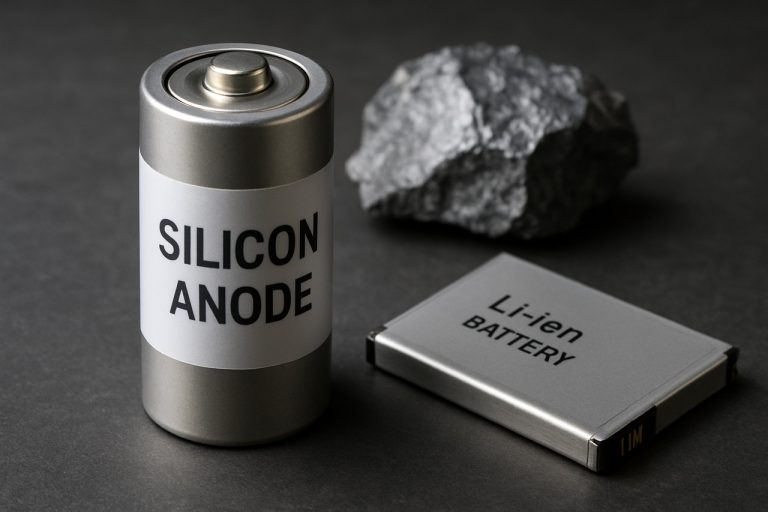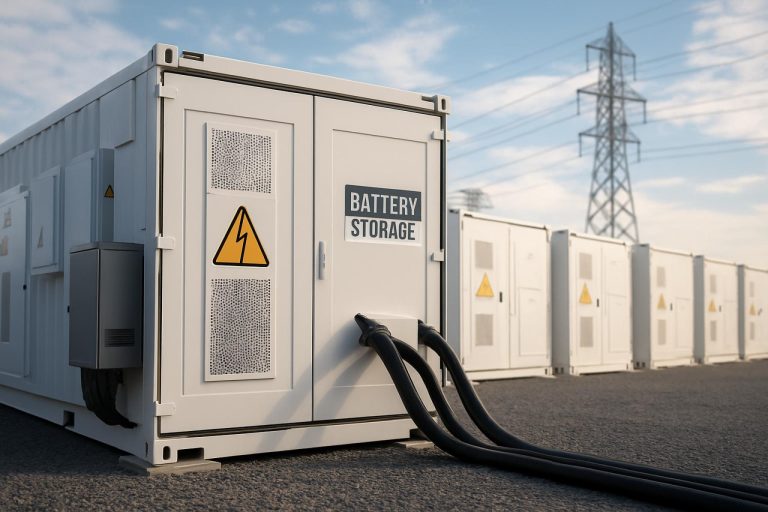
Revolutionizing the Grid: How Battery & Energy Storage Innovations in 2025 Will Reshape Power Infrastructure. Explore the Technologies, Market Growth, and Future Outlook Driving the Next Energy Era.
- Executive Summary: Key Trends and Market Drivers in 2025
- Market Size, Growth Forecasts, and CAGR Analysis (2025–2030)
- Technology Landscape: Lithium-Ion, Flow, and Emerging Chemistries
- Grid Integration: Enhancing Reliability and Flexibility
- Policy, Regulation, and Incentives Shaping the Sector
- Leading Players and Strategic Partnerships
- Cost Reductions, Scalability, and Supply Chain Innovations
- Case Studies: Utility-Scale Deployments and Pilot Projects
- Sustainability, Recycling, and Lifecycle Management
- Future Outlook: Disruptive Technologies and Long-Term Market Impact
- Sources & References
Executive Summary: Key Trends and Market Drivers in 2025
Grid-scale battery and energy storage innovations are set to play a pivotal role in the global energy transition in 2025 and the years immediately following. As renewable energy penetration accelerates, the need for reliable, flexible, and cost-effective storage solutions is driving rapid technological advancement and large-scale deployment. Several key trends and market drivers are shaping this sector.
First, lithium-ion battery technology continues to dominate new grid-scale installations due to its proven performance, declining costs, and established supply chains. Major manufacturers such as Contemporary Amperex Technology Co. Limited (CATL) and LG Energy Solution are expanding production capacity and introducing next-generation chemistries with improved energy density, safety, and cycle life. In 2025, CATL is expected to further scale up its LFP (lithium iron phosphate) offerings, which are increasingly favored for stationary storage due to their thermal stability and lower cost compared to nickel-based chemistries.
Second, the market is witnessing a surge in long-duration energy storage (LDES) projects, essential for balancing intermittent renewables over multi-hour or multi-day periods. Technologies such as flow batteries, advanced compressed air, and thermal storage are gaining traction. Companies like ESS Inc. are deploying iron flow battery systems, while Form Energy is advancing multi-day iron-air battery technology, with commercial projects slated for deployment in the U.S. and Europe by 2025.
Third, policy support and grid modernization initiatives are accelerating investment. The U.S. Department of Energy’s ongoing funding for energy storage demonstration projects, along with the European Union’s focus on grid resilience and decarbonization, are catalyzing large-scale deployments. Utilities and grid operators are increasingly procuring storage as a non-wires alternative to traditional infrastructure upgrades, with companies like Tesla and Siemens Energy delivering turnkey battery energy storage systems (BESS) for grid balancing, frequency regulation, and peak shaving.
Looking ahead, the outlook for grid-scale storage in 2025 and beyond is robust. Global installed capacity is projected to surpass 500 GWh by 2025, with Asia-Pacific, North America, and Europe leading deployments. Continued innovation in battery chemistries, digital controls, and hybrid systems (integrating storage with renewables and hydrogen) will further enhance grid flexibility and reliability. As costs continue to decline and regulatory frameworks mature, grid-scale storage is poised to become a cornerstone of the modern, decarbonized power system.
Market Size, Growth Forecasts, and CAGR Analysis (2025–2030)
The grid-scale battery and energy storage sector is poised for robust expansion between 2025 and 2030, driven by accelerating renewable energy integration, grid modernization efforts, and the global push for decarbonization. As of 2025, global installed grid-scale battery storage capacity is estimated to surpass 100 GW, with leading markets including the United States, China, and Europe. This growth is underpinned by ambitious policy targets, declining battery costs, and increasing demand for grid flexibility and reliability.
Key players such as Tesla, Inc., LG Energy Solution, Contemporary Amperex Technology Co., Limited (CATL), and Fluence Energy, Inc. are scaling up manufacturing and deployment of advanced lithium-ion and alternative battery chemistries. For example, Tesla, Inc. continues to expand its Megapack installations globally, while CATL is investing in new gigafactories and next-generation battery technologies, including sodium-ion and long-duration storage solutions.
The compound annual growth rate (CAGR) for grid-scale battery storage is projected to range between 25% and 30% through 2030, with annual additions expected to accelerate as more utilities and grid operators adopt storage to support variable renewable energy sources. In the United States, the Department of Energy has set a target of deploying 100 GW of energy storage by 2030, reflecting the sector’s strategic importance for grid resilience and clean energy goals. Similarly, China’s National Energy Administration is driving rapid deployment, with several provinces mandating storage integration alongside new wind and solar projects.
Beyond lithium-ion, innovation is accelerating in alternative chemistries and long-duration storage. Companies like Fluence Energy, Inc. and LG Energy Solution are piloting and commercializing flow batteries, while CATL and others are advancing sodium-ion and hybrid systems. These innovations are expected to diversify the market and address challenges related to cost, safety, and duration, further fueling market growth.
Looking ahead, the grid-scale battery and energy storage market is set to play a pivotal role in enabling the energy transition, with strong policy support, technological advancements, and increasing private and public investment. The sector’s rapid growth trajectory is expected to continue well into the next decade, positioning energy storage as a cornerstone of modern, resilient, and sustainable power systems.
Technology Landscape: Lithium-Ion, Flow, and Emerging Chemistries
Grid-scale battery and energy storage technologies are undergoing rapid innovation as utilities and grid operators seek solutions to integrate more renewable energy, enhance grid reliability, and support decarbonization goals. As of 2025, lithium-ion (Li-ion) batteries continue to dominate new deployments, but alternative chemistries—such as flow batteries and emerging solid-state or sodium-based systems—are gaining traction due to their potential for improved safety, longevity, and cost-effectiveness.
Li-ion batteries remain the workhorse of grid-scale storage, accounting for the vast majority of new installations worldwide. Their high energy density, declining costs, and established supply chains have enabled large-scale projects, such as the 1.6 GWh Moss Landing Energy Storage Facility operated by Vistra Corp. in California. Major manufacturers like Contemporary Amperex Technology Co. Limited (CATL) and LG Energy Solution are scaling up production to meet surging demand, with CATL unveiling new high-cycle-life Li-ion products specifically designed for grid applications. However, concerns over resource constraints (notably lithium and cobalt), fire safety, and cycle life for long-duration storage are driving interest in alternative chemistries.
Flow batteries, particularly vanadium redox flow batteries (VRFBs), are emerging as a promising solution for long-duration energy storage (LDES). These systems offer the ability to independently scale power and energy, long operational lifespans (often exceeding 20 years), and enhanced safety due to their aqueous electrolytes. Companies such as Invinity Energy Systems and Sumitomo Electric Industries are deploying multi-megawatt VRFB projects in Europe, North America, and Asia. In 2024, Invinity commissioned a 2.8 MWh system in the UK, while Sumitomo continues to expand its installations in Japan and Southeast Asia. These deployments are expected to accelerate through 2025 as policy incentives and grid needs for multi-hour storage grow.
Emerging chemistries are also advancing rapidly. Sodium-ion batteries, championed by CATL and Faradion, are entering pilot-scale grid projects, offering lower material costs and improved sustainability. Solid-state batteries, while still in early commercialization, are being developed by companies like QuantumScape for future grid and mobility applications, promising higher energy density and enhanced safety. Meanwhile, iron-air batteries, such as those from Form Energy, are being piloted for ultra-long-duration storage, with Form Energy’s first 100-hour system slated for deployment in 2025.
Looking ahead, the technology landscape for grid-scale storage is expected to diversify significantly. While Li-ion will likely retain a dominant share through the next few years, flow batteries and new chemistries are poised to capture a growing portion of the market, particularly for applications requiring longer durations, greater safety, or lower environmental impact. This innovation wave is set to underpin the next phase of global grid modernization and renewable integration.
Grid Integration: Enhancing Reliability and Flexibility
Grid-scale battery and energy storage innovations are rapidly transforming the reliability and flexibility of modern power grids, especially as renewable energy penetration accelerates. In 2025, the deployment of advanced battery systems—primarily lithium-ion, but increasingly including long-duration chemistries such as iron-air, sodium-ion, and flow batteries—is expected to reach new milestones in both capacity and operational sophistication.
Major industry players are scaling up manufacturing and project deployment. Tesla, Inc. continues to expand its Megapack installations, with multi-gigawatt-hour projects in the United States, Europe, and Australia. These systems are designed for grid balancing, frequency regulation, and renewable integration, with individual sites now exceeding 1 GWh of storage. LG Energy Solution and Samsung SDI are also ramping up production of grid-scale battery cells, focusing on improved cycle life and safety.
Beyond lithium-ion, new chemistries are gaining traction for long-duration storage. ESS Inc. is deploying iron flow battery systems, which offer up to 12 hours of discharge and are being piloted for renewable smoothing and capacity shifting. Form Energy is commercializing iron-air batteries, targeting multi-day storage to address the intermittency of wind and solar. These technologies are expected to move from demonstration to early commercial deployment by 2025–2026, with several utility-scale projects underway.
The integration of these storage assets is being facilitated by advanced grid management software and digital platforms. Siemens AG and Hitachi Energy are providing energy management systems that optimize battery dispatch, support virtual power plants, and enable participation in ancillary service markets. These platforms are critical for maximizing the value of storage, allowing batteries to respond dynamically to grid needs in real time.
Looking ahead, the outlook for grid-scale storage is robust. The International Energy Agency projects global installed battery storage capacity to surpass 500 GWh by 2025, with annual additions accelerating as costs decline and regulatory frameworks mature. Key challenges remain—such as supply chain constraints for critical minerals and the need for standardized interconnection protocols—but ongoing innovation and investment from leading manufacturers and utilities are expected to drive continued growth and grid reliability improvements through the remainder of the decade.
Policy, Regulation, and Incentives Shaping the Sector
Policy, regulation, and incentives are playing a pivotal role in accelerating grid-scale battery and energy storage innovations as the world transitions toward cleaner energy systems. In 2025 and the coming years, governments and regulatory bodies are intensifying efforts to integrate large-scale storage into national grids, recognizing its critical function in balancing intermittent renewable generation and enhancing grid resilience.
In the United States, the Inflation Reduction Act (IRA) of 2022 continues to have a transformative impact, with its investment tax credit (ITC) for standalone energy storage projects now fully in effect. This policy is expected to drive a surge in grid-scale battery deployments through 2025 and beyond, as developers and utilities capitalize on the financial incentives to lower project costs and accelerate timelines. The Federal Energy Regulatory Commission (FERC) has also advanced rules to facilitate storage participation in wholesale markets, further opening revenue streams for operators.
At the state level, California remains a leader, with the California Public Utilities Commission mandating significant storage procurement targets for utilities, aiming for over 4,000 MW of new storage by mid-decade. New York, through its Climate Leadership and Community Protection Act, is targeting 6,000 MW of energy storage by 2030, with interim milestones and funding programs to support rapid deployment. These state-level mandates are complemented by streamlined permitting processes and grid interconnection reforms, reducing barriers for large-scale projects.
In Europe, the European Union’s REPowerEU plan and the updated Renewable Energy Directive are driving member states to accelerate storage adoption as part of broader decarbonization and energy security strategies. The European Commission has introduced new guidelines for state aid, allowing direct support for energy storage projects, while the European Network of Transmission System Operators for Electricity (ENTSO-E) is working to harmonize grid codes and market access for storage across borders.
Asia-Pacific markets are also seeing robust policy support. In China, the National Energy Administration has set ambitious targets for non-hydro energy storage, aiming for at least 30 GW of capacity by 2025, with provincial governments offering subsidies and favorable grid tariffs. Australia’s regulatory reforms, including the introduction of the Integrated System Plan by the Australian Energy Market Operator, are incentivizing large-scale battery investments to support renewable integration and grid stability.
Looking ahead, the convergence of supportive policies, evolving market rules, and targeted incentives is expected to sustain rapid growth in grid-scale battery and energy storage deployments. Major industry players such as Tesla, LG Energy Solution, Contemporary Amperex Technology Co. Limited (CATL), and Siemens are poised to benefit from these regulatory tailwinds, scaling up manufacturing and project development to meet surging demand.
Leading Players and Strategic Partnerships
The grid-scale battery and energy storage sector is witnessing rapid transformation in 2025, driven by a combination of technological innovation, ambitious deployment targets, and strategic alliances among leading industry players. As global electricity grids integrate more variable renewable energy sources, the need for large-scale, reliable storage solutions has become paramount. This has spurred both established companies and emerging innovators to form partnerships and invest heavily in next-generation storage technologies.
Among the most prominent players, Tesla, Inc. continues to expand its global footprint with its Megapack lithium-ion battery systems, which are being deployed in utility-scale projects across North America, Europe, and Asia-Pacific. Tesla’s vertically integrated approach, from cell manufacturing at its Gigafactories to project deployment, has enabled it to secure major contracts with utilities and grid operators. In 2024 and 2025, Tesla has announced new partnerships with energy providers in Australia and the United States to deliver multi-gigawatt-hour storage installations.
Another key player, LG Energy Solution, is leveraging its expertise in advanced battery chemistries to supply large-scale storage systems for grid applications. The company has entered into joint ventures with power producers and infrastructure developers in Europe and Asia, focusing on both lithium-ion and next-generation battery technologies. LG Energy Solution’s collaborations aim to address grid stability and renewable integration challenges, with several projects scheduled for commissioning by 2026.
In the realm of alternative chemistries, Siemens Energy and Northvolt AB have formed a strategic partnership to develop and deploy sustainable battery storage solutions tailored for grid-scale use. Northvolt, known for its commitment to sustainable manufacturing and recycling, brings expertise in high-performance battery cells, while Siemens Energy contributes its grid integration and project management capabilities. Their joint projects in Germany and Scandinavia are set to come online in the next two years, targeting both frequency regulation and renewable energy smoothing.
Flow battery technology is also gaining traction, with Vionx Energy and Invinity Energy Systems leading deployments of vanadium redox flow batteries for long-duration storage. These companies are collaborating with utilities and industrial partners to demonstrate the scalability and durability of flow batteries, with several pilot and commercial projects underway in the United States and the United Kingdom.
Looking ahead, the sector is expected to see further consolidation and cross-sector partnerships, as energy storage becomes integral to grid modernization and decarbonization strategies. The ongoing collaboration between battery manufacturers, utilities, and technology providers is poised to accelerate the deployment of innovative storage solutions, supporting the global transition to cleaner and more resilient energy systems.
Cost Reductions, Scalability, and Supply Chain Innovations
Grid-scale battery and energy storage technologies are undergoing rapid transformation in 2025, driven by the dual imperatives of cost reduction and scalability. The sector is witnessing significant advancements in manufacturing processes, supply chain integration, and material sourcing, all of which are critical to meeting the surging global demand for renewable energy integration and grid stability.
One of the most notable trends is the continued decline in the cost of lithium-ion battery systems, which remain the dominant technology for grid-scale storage. Major manufacturers such as Contemporary Amperex Technology Co. Limited (CATL) and LG Energy Solution have expanded their gigafactory footprints, leveraging economies of scale and advanced automation to drive down production costs. CATL, for example, has announced new facilities in China and Europe, aiming to further reduce per-kilowatt-hour costs through vertical integration and improved supply chain logistics.
In parallel, alternative chemistries are gaining traction as supply chain constraints and raw material price volatility—especially for lithium, cobalt, and nickel—prompt diversification. Form Energy is commercializing iron-air battery systems, which utilize abundant and low-cost materials, offering multi-day storage at a fraction of the cost of traditional lithium-ion solutions. Similarly, ESS Inc. is scaling up production of iron flow batteries, targeting utility-scale deployments with long-duration capabilities and minimal reliance on critical minerals.
Supply chain innovation is also a focal point, with companies investing in localized sourcing and recycling initiatives to mitigate geopolitical risks and environmental impacts. Tesla has accelerated its battery recycling programs and is working to secure domestic supply chains for key materials in North America and Europe. Meanwhile, Northvolt is building out a closed-loop battery ecosystem in Europe, integrating recycling and manufacturing to reduce both costs and carbon footprint.
Looking ahead, the outlook for grid-scale storage is robust. The International Energy Agency projects global battery storage capacity to more than triple by 2030, with annual installations surpassing 100 GW by the late 2020s. Continued innovation in manufacturing, chemistry, and supply chain management is expected to further lower costs and enable broader deployment, supporting the transition to a more resilient and decarbonized energy system.
Case Studies: Utility-Scale Deployments and Pilot Projects
Grid-scale battery and energy storage innovations are rapidly transforming the global electricity landscape, with 2025 marking a pivotal year for large-scale deployments and pilot projects. Utilities and technology providers are scaling up both the size and sophistication of storage systems, aiming to enhance grid reliability, integrate renewables, and support decarbonization goals.
One of the most prominent case studies is the ongoing expansion of the Moss Landing Energy Storage Facility in California, operated by Vistra Corp.. As of early 2025, Moss Landing has reached a capacity of 750 MW/3,000 MWh, making it one of the world’s largest lithium-ion battery installations. The facility provides critical grid services, including frequency regulation and peak shaving, and is a model for how storage can replace retiring fossil fuel plants.
In Australia, Tesla, Inc. continues to partner with utilities for large-scale battery deployments. The Victorian Big Battery, a 300 MW/450 MWh system, has demonstrated the ability to prevent blackouts and stabilize the grid during extreme weather events. Tesla’s Megapack technology is also being adopted in new projects across Europe and North America, with several 2025 pilot projects focusing on grid-forming inverters and virtual power plant integration.
Europe is witnessing significant activity as well. Enel S.p.A. is piloting hybrid storage systems in Italy and Spain, combining lithium-ion batteries with flow batteries to optimize both short- and long-duration storage. These pilots are designed to test the economic and technical viability of multi-technology storage for renewable integration and grid balancing.
In the United States, NextEra Energy, Inc. is deploying multiple utility-scale battery projects, including a 400 MW/1,600 MWh installation in Florida, which is expected to come online in 2025. These projects are part of a broader strategy to pair storage with solar generation, enabling dispatchable clean energy and reducing reliance on natural gas peaker plants.
Meanwhile, Fluence Energy, Inc. is leading several pilot projects in Asia and the Middle East, focusing on grid resilience and renewable integration. Their modular storage platforms are being tested for applications ranging from frequency response to black start capabilities.
Looking ahead, the next few years are expected to see further scaling of battery storage, with increasing emphasis on long-duration technologies, such as flow batteries and advanced chemistries. These case studies underscore the sector’s momentum and the critical role of utility-scale storage in the energy transition.
Sustainability, Recycling, and Lifecycle Management
Grid-scale battery and energy storage systems are rapidly evolving to address the twin imperatives of sustainability and lifecycle management. As deployment accelerates worldwide, the industry is focusing on reducing environmental impact, improving recyclability, and extending the useful life of storage assets. In 2025 and the coming years, several key trends and initiatives are shaping the sector.
A major development is the integration of circular economy principles into battery manufacturing and end-of-life processes. Leading battery manufacturers such as Contemporary Amperex Technology Co., Limited (CATL) and LG Energy Solution are investing in closed-loop recycling systems. These systems recover valuable materials like lithium, nickel, and cobalt from spent batteries, reducing the need for virgin resource extraction and minimizing waste. For example, CATL has established dedicated recycling subsidiaries and partnerships to process used batteries from grid and electric vehicle applications, aiming to recover over 90% of key metals.
In North America and Europe, companies such as Northvolt are pioneering sustainable battery production by using recycled materials in new cells. Northvolt’s Revolt program targets the production of batteries with 50% recycled content by the end of the decade, with significant milestones expected by 2025. This approach not only reduces the carbon footprint of grid-scale storage but also addresses supply chain vulnerabilities for critical minerals.
Lifecycle management is also being enhanced through advanced battery management systems (BMS) and predictive analytics. These technologies, developed by companies like Siemens and Hitachi Energy, enable real-time monitoring of battery health, optimize charging cycles, and extend operational lifespans. By maximizing usable life and facilitating second-life applications—such as repurposing EV batteries for stationary storage—these solutions contribute to a more sustainable grid infrastructure.
Policy and regulatory frameworks are evolving in tandem. The European Union’s Battery Regulation, coming into force in 2025, will require manufacturers to meet strict recycling efficiency targets and provide detailed lifecycle information. This is prompting industry-wide adoption of digital battery passports and transparent supply chain tracking, with support from organizations like Battery Europe.
Looking ahead, the convergence of recycling innovation, digital lifecycle management, and supportive regulation is expected to make grid-scale energy storage significantly more sustainable. As these practices scale, the sector will play a crucial role in enabling a circular, low-carbon energy system.
Future Outlook: Disruptive Technologies and Long-Term Market Impact
Grid-scale battery and energy storage innovations are poised to play a transformative role in the global energy landscape through 2025 and beyond. As renewable energy penetration accelerates, the need for reliable, flexible storage solutions is driving rapid technological advancement and large-scale deployment. Several disruptive technologies and market trends are shaping the future outlook for this sector.
One of the most significant developments is the maturation and scaling of lithium iron phosphate (LFP) battery technology. LFP batteries, known for their safety, longevity, and cost-effectiveness, are increasingly favored for grid applications. Major manufacturers such as Contemporary Amperex Technology Co., Limited (CATL) and BYD Company Limited are expanding their production capacities and launching new grid-scale LFP solutions, with multi-gigawatt-hour projects announced for 2025. These advancements are expected to further reduce the levelized cost of storage, making large-scale battery installations more economically viable.
Beyond lithium-ion, alternative chemistries are gaining traction. Sodium-ion batteries, which offer lower material costs and improved sustainability, are moving from pilot to commercial scale. CATL has announced plans to commercialize sodium-ion batteries for stationary storage, targeting deployment in 2025. Meanwhile, flow battery technologies—such as vanadium redox and zinc-bromine—are being advanced by companies like Invinity Energy Systems and ESS Inc., offering multi-hour to multi-day storage capabilities and long cycle life, which are critical for grid balancing and renewable integration.
Hybrid energy storage systems, which combine batteries with other technologies such as pumped hydro or hydrogen, are also emerging as a disruptive trend. These systems can provide both short-term frequency regulation and long-duration energy shifting, enhancing grid resilience. Siemens Energy and Hitachi Energy are actively developing integrated solutions that leverage digital controls and advanced analytics to optimize performance and value.
Looking ahead, the market impact of these innovations is expected to be profound. The International Energy Agency projects global grid-scale battery storage capacity to exceed 500 GW by 2030, with annual installations accelerating through the second half of the decade. As costs continue to decline and performance improves, grid-scale storage will become a cornerstone of decarbonized power systems, enabling higher shares of renewables, supporting electrification, and providing critical grid services. The next few years will be pivotal as new technologies move from demonstration to widespread adoption, reshaping energy markets and infrastructure worldwide.
Sources & References
- Contemporary Amperex Technology Co. Limited (CATL)
- Form Energy
- Siemens Energy
- Fluence Energy, Inc.
- Vistra Corp.
- Invinity Energy Systems
- Sumitomo Electric Industries
- Faradion
- QuantumScape
- Form Energy
- Siemens AG
- Hitachi Energy
- Northvolt AB
- Invinity Energy Systems
- Enel S.p.A.
- NextEra Energy, Inc.



